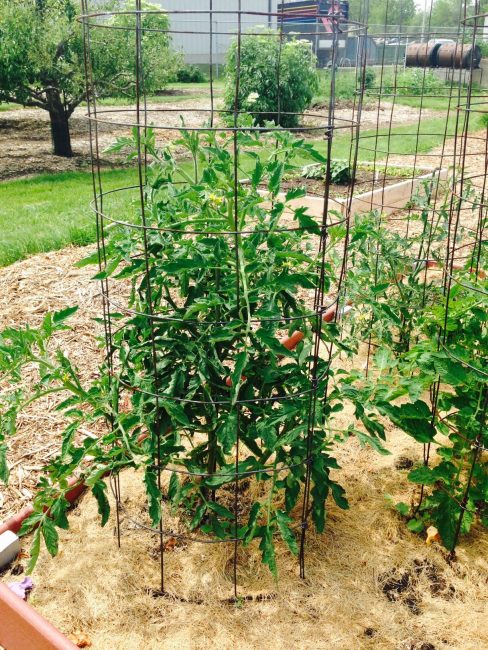by Vijai Pandian, Horticulture Educator

Tomato cages made of concrete reinforcement mesh provide better support for large tomato plants than standard tomato cages found at garden stores. They also have larger gaps that allow for easier harvesting.
Gardening season is in full swing, complete with all of the challenges and mysteries that can pop up. Here are some tips to help you with mid-summer gardening challenges and surprises.
DIY tomato cages help with large tomato plants:
Tomato cages offer a simple means to support and contain overgrown indeterminate tomato varieties. However standard cages sold at the garden centers need additional anchorage to hold the overgrown plants and are not big enough to contain the plants. You can build a large tomato cage using concrete reinforcement mesh wielded into a cylindrical ring (3’ diameter) with the bottom ends staked into the ground. These large cages provide better support to the indeterminate varieties and their mesh size is large enough to allow for easy harvest.
What do I do with potato plants’ blossoms and berries?
Mature potato plants tend to produce small berries containing true-to-type seeds. However, these seeds are non-edible and can drain plants’ energy. It’s better to cut the flower stalk to prevent from setting fruits.
White powdery dust on cucumber and squash leaves?
Hot and humid weather condition triggers a fungal disease called powdery mildew coating the upper and lower surface of the leaves with white powdery spores. Many ornamentals and vegetable crop plants are tolerant to powdery mildew disease and do not require spray treatments. However, cucumbers, pumpkins, squash, phlox, and zinnias are highly susceptible to this disease and can cause severe defoliation.
To minimize the infection, train cucumbers on a trellis, schedule irrigation in early morning hours, and always water to the base of the plants. You can apply preventive fungicide as soon as the sign of infection is noticed. A thorough foliar application is required and should be repeated every 7 to 14 days until the humid weather subsides. For a list of fungicides, refer to the Extension factsheet on Home Vegetable Garden Fungicides.
Distorted and twisted tomato leaves?
Tomatoes are highly sensitive to common lawn herbicides containing 2,4 D and dicamba that can easily drift in vapor form when applied during hot (85 F), dry and windy days. Common symptoms include twisted, flat, and abnormal-shaped leaves. Usually, the terminal ends of the plants are the first to develop the symptoms. Unfortunately, not much can be done to the injured leaves, however subsequent new growth will be normal.
Did your beans fail to set pods?
Beans and pepper flowers are sensitive to temperatures exceeding 85 F coupled with dry winds. Plants tend to stop flowering under high temperatures and will continue until it cools down to 75 F. Mulching and regular watering helps the beans to retains their blossom.
For any lawn and gardening questions click the link below.



